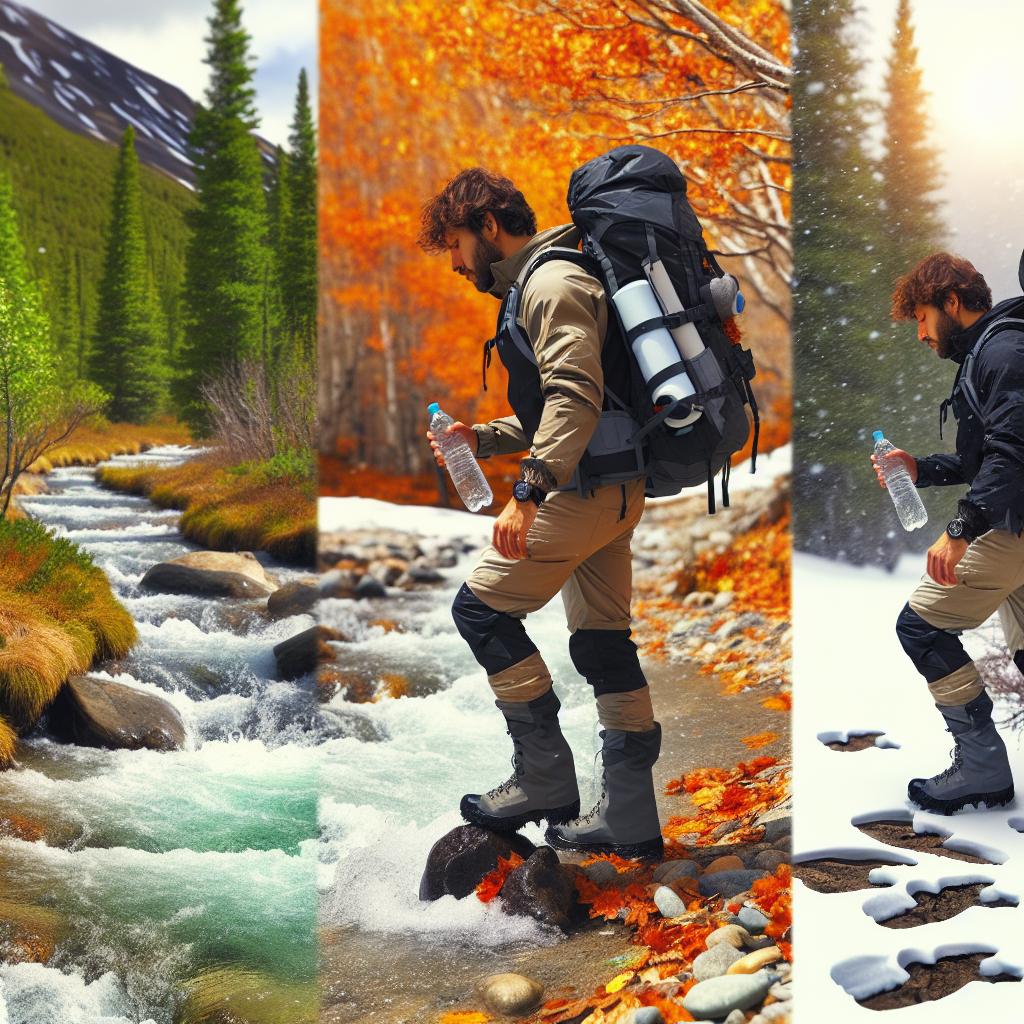Deep within the verdant embrace of the Great Smoky Mountains lies a labyrinth of trails that beckon the seasoned hiker. These pathways wind through ancient forests, scale craggy peaks draped in mist, and skirt the edges of precipitous cliffs. They offer both peril and promise to those intrepid souls who seek not just a stroll in the park, but a true test of grit and endurance. Whether it’s the relentless ascents that leave calves quivering or the precipitous descents that demand unyielding concentration, the Smokies present a formidable playground for the experienced hiker. In this article, we’ll embark on a journey through the most challenging trails that this storied range has to offer, unraveling the secrets and trials that lie in wait for those daring enough to seek them out.
Exploring Rugged Terrain: The Physical Demands of Smoky Mountain Trails
The Smoky Mountains offer a labyrinth of trails that are not just scenic but also physically demanding, making them perfect for seasoned hikers. These paths blend challenging terrain with breathtaking vistas, dense forests, and cascading waterfalls. A prime example is the Alum Cave Trail, which takes hikers up to Mount LeConte. This trail is notable for its strenuous ascent, narrow rock ledges, and steep drop-offs. Hikers should be prepared for the grueling final stretch called “The Narrows,” where the path is barely wide enough for one person. Other tough trails include:
- Charlies Bunion: A rugged 8-mile trail with steep switchbacks and scenic views.
- Chimney Tops: Despite being only 4 miles round trip, its short, intense climb and rock-scrambling sections demand significant effort.
For those seeking elevation gains and rocky, unforgiving paths, the Boulevard Trail to Mount LeConte is another formidable challenge. This trail features a mix of high ridges and deep ravines, requiring hikers to navigate tricky terrain while managing an elevation gain of over 3,000 feet. It also converges with the Appalachian Trail, adding another degree of difficulty. Below is a snapshot of the elevation and difficulty levels of these trails:
| Trail Name | Difficulty Level | Elevation Gain |
|---|---|---|
| Alum Cave Trail | High | 2763 ft |
| Charlies Bunion | Medium-High | 1641 ft |
| Chimney Tops | High | 1487 ft |
| Boulevard Trail | Very High | 3000+ ft |
Uncharted Paths: Navigating Lesser-Known Challenging Routes
Deep within the vast wilderness of the Smoky Mountains lies a network of trails that beckon to the bravest of adventurers. For those with a seasoned set of hiking boots and a thirst for untamed landscapes, these routes offer both challenge and reward. Alum Cave Trail, for instance, starts as a gentle pathway but soon turns into a strenuous climb, rewarding hikers with panoramic views from Mount LeConte. Similarly, the Forney Ridge Trail presents steep ascensions and rocky passages, leading to the scenic beauty of Andrews Bald, particularly breathtaking during the rhododendron bloom.
Venturing deeper, the Boulevard Trail lures experienced hikers with its narrow passages and rugged terrain, culminating at the summit of Mount LeConte. The atmospheres shift dramatically through this trail, from dense, misty woods to open, sunlit spaces. Not to be outdone, the Rocky Top Trail offers a grueling ascent, but at the summit, hikers are greeted with unparalleled views of the sprawling Smokies. These trails are not for the faint-hearted but are ideal challenges for those seeking to commune intimately with nature, far from the more trodden paths.

Endurance Essentials: Preparing for High-Elevation Hikes
Preparing for a high-elevation hike in the Smoky Mountains demands a blend of physical training and strategic planning. First and foremost, acclimatization is key. Spending time at higher altitudes before your hike helps your body adapt to the lower oxygen levels. Make sure to incorporate endurance exercises into your training regimen, focusing on leg strength with activities like squats and lunges. Equally important is cardiovascular conditioning—running, cycling, and swimming can all help improve stamina. Additionally, your hiking gear must be carefully curated to handle varying weather conditions and rugged terrains.
Essential items to include in your backpack are:
- Navigation tools: Map, compass, or GPS device
- Hydration system: Water bottles or reservoir with at least 2 liters capacity
- Nutrition: High-energy snacks like trail mix, energy bars, and dried fruits
- Clothing: Layered clothing for temperature changes
- Safety gear: First-aid kit, headlamp, and a multi-tool
Here’s a quick reference table for recommended gear:
| Item | Purpose |
|---|---|
| Map & Compass | Navigation |
| Water Bottles/Reservoir | Hydration |
| Energy Bars | Nutritional Support |
| Layered Clothing | Temperature Regulation |
| First-aid Kit | Emergency Aid |

Seasonal Challenges: Tackling Weather and Wildlife on the Trail
The Smoky Mountains present a unique blend of seasonal hurdles and wildlife encounters that can test even the most seasoned hikers. During the winter months, trails like the Alum Cave Trail transform into icy gauntlets, demanding crampons and impeccable balance. Conversely, summer brings sweltering heat and swarms of mosquitoes along the Low Gap Trail, turning each step into a test of endurance. Spring and fall are no less challenging as blooming flora and falling leaves can obscure the trail, putting your navigation skills to the test.
Wildlife adds another layer of complexity to these hikes. The less-trodden Forney Creek Trail is notorious for bear sightings, requiring keen vigilance and potentially bear spray. Meanwhile, the Grotto Falls Trail often has slippery rocks that can become hazardous, especially when wet from morning dew. It’s critical to be aware of your surroundings and take appropriate precautions for animal encounters and slick conditions alike.
| Trail | Seasonal Challenge | Wildlife Encounters |
|---|---|---|
| Alum Cave Trail | Icy paths in winter | Minimal |
| Low Gap Trail | Heat in summer | Mosquitoes |
| Forney Creek Trail | Unaffected by season | Bears |
| Grotto Falls Trail | Slippery rocks | Minimal |
Q&A
Q: What makes the Smoky Mountains a prime destination for experienced hikers?
A: The Smoky Mountains offer a captivating blend of rugged terrain, diverse ecosystems, and dramatic vistas. The region is renowned for its ancient mountains, winding streams, and abundant wildlife, providing a perfect backdrop for demanding hikes that challenge even seasoned adventurers.
Q: Which trail is often considered the most difficult in the Smoky Mountains?
A: The Alum Cave Trail, particularly when extended to Mount LeConte, is frequently cited as one of the most challenging hikes. The trail climbs steeply over rock formations, through narrow passageways, and along exposed edges, ultimately rewarding hikers with breathtaking panoramic views from one of the park’s highest peaks.
Q: Are there any other trails that pose a significant challenge?
A: Yes, the Appalachian Trail section through the Smokies, known for its relentless elevation gains and losses, stands out. The trek from Fontana Dam to Davenport Gap covers approximately 72 miles, including a climb to the highest point on the Appalachian Trail, Clingmans Dome, presenting a continuous test of endurance and skill.
Q: What about the Charlies Bunion Trail?
A: Charlies Bunion via the Kephart Prong Trail is another formidable hike. It’s approximately 9 miles round trip, featuring steep ascents and potentially treacherous switchbacks. The exposed, rocky outcrop at the end offers both an exhilarating view and a stern reminder of nature’s raw power.
Q: Is Ramsey Cascades Trail suitable for experienced hikers seeking a challenge?
A: Absolutely. Ramsey Cascades is the highest waterfall in the park, and reaching it requires ascending 4,000 feet over an 8-mile round trip. The path weaves through old-growth forests, across roaring streams, and over slippery rocks, culminating in an awe-inspiring cascade of water.
Q: Are there specific preparations hikers should make for these trails?
A: Hikers tackling these demanding trails should be prepared with sufficient water, high-energy snacks, and weather-appropriate gear. Physical preparation is essential, as is familiarity with trail maps and conditions. Given the trails’ steep and hazardous sections, experience in backcountry navigation and a cautious approach are crucial.
Q: Do these trails provide any additional rewards beyond the physical challenge?
A: Indeed, the trials of these trails are counterbalanced by stunning rewards: sweeping mountain views, lush forests teeming with diverse flora and fauna, and the profound sense of accomplishment upon conquering nature’s formidable hurdles. The Smoky Mountains promise an unforgettable adventure for those daring enough to embrace their toughest paths.
Future Outlook
As we conclude our journey through the most challenging hiking trails in the Smoky Mountains, we are reminded that the essence of hiking isn’t solely in conquering peaks or traversing rugged paths. It’s about the experience that lies between each heartbeat and every step – the silent whispers of ancient forests, the symphony of cascading streams, and the ever-changing palette of the sky. For the seasoned hikers who seek the thrill of these formidable trails, the Smoky Mountains do not disappoint. They offer a canvas where nature and adventure merge, painting memories that endure long after the journey ends. So lace up your boots, take a deep breath, and let the allure of the Smokies guide your next adventure, for the mountains are calling, and the paths to be taken are as boundless as your spirit.

